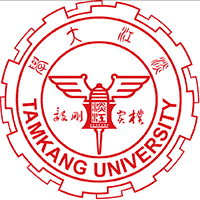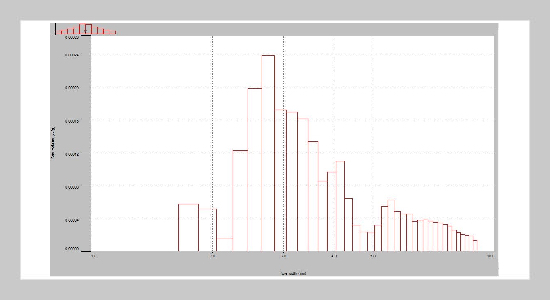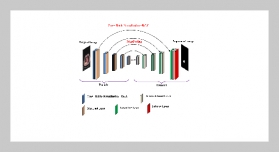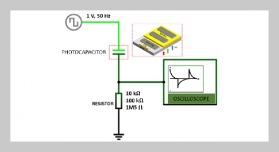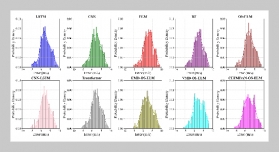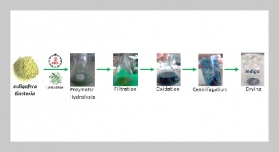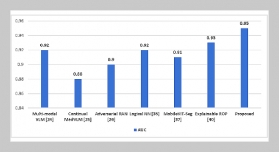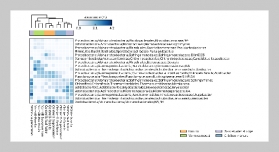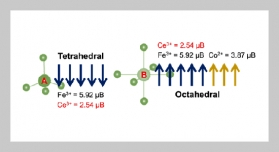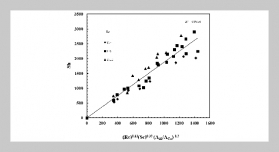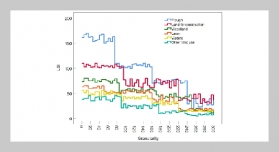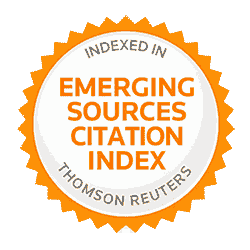- [1] H. Yin, P. Qiu, Y. Qian, Z. Kong, X. Zheng, Z. Tang, and H. Guo, (2019) “Textile wastewater treatment for water reuse: a case study" Processes 7(1): 34. DOI: 10.3390/pr7010034.
- [2] M. D. G. de Luna, E. D. Flores, D. A. D. Genuino, C. M. Futalan, and M.-W. Wan, (2013) “Adsorption of Eriochrome Black T (EBT) dye using activated carbon prepared from waste rice hulls—Optimization, isotherm and kinetic studies" Journal of the Taiwan institute of chemical engineers 44(4): 646–653. DOI: 10.1016/j.jtice.2013.01.010.
- [3] Z. Cigeroglu and E. Yıldırır, (2021) “Ultrasonic Assisted Removal of Eriochrome Black T onto Vermicom post: Characterization, Isotherm and Kinetic Modelling" Journal of the Turkish Chemical Society Section A: Chemistry 8(4): 1251–1262. DOI: 10.18596/jotcsa.997521.
- [4] A. Lahkimi, M. A. Oturan, N. Oturan, and M. Chaouch, (2007) “Removal of textile dyes from water by the electro-Fenton process" Environmental Chemistry Letters 5: 35–39. DOI: 10.1007/s10311-006-0058-x.
- [5] B. Han, T. Runnells, J. Zimbron, and R. Wickramasinghe, (2002) “Arsenic removal from drinking water by flocculation and microfiltration" Desalination 145(1-3): 293–298. DOI: 10.1016/S0011-9164(02)00425-3.
- [6] A. M. Al-Msiedeen, M. W. Alsagarat, A. Al Nawaiseh, and R. M. Jamhour, (2024) “Benzene Contaminant Removal from Hydraulic Fracking Water Using Marine Macroalgae Biosorbent: Kinetic and Thermodynamic Study" Russian Journal of Physical Chemistry A98(5): 1076–1090. DOI: 10.1134/S0036024424050042.
- [7] A. Houas, H. Lachheb, M. Ksibi, E. Elaloui, C. Guil lard, and J.-M. Herrmann, (2001) “Photocatalyticdegra dation pathway of methylene blue in water" Applied Catalysis B: Environmental 31(2): 145–157. DOI: 10.1016/S0926-3373(00)00276-9.
- [8] M. Panizza, A. Barbucci, R. Ricotti, and G. Cerisola, (2007) “Electrochemical degradation of methylene blue" Separation and purification technology 54(3): 382 387. DOI: 10.1016/j.seppur.2006.10.010.
- [9] M.d. A. Bezerra, M. A. Z. Arruda, and S. L. C. Ferreira, (2005) “Cloud point extraction as a procedure of separation and pre-concentration for metal determination using spectro analytical techniques: a review" Applied Spectroscopy Reviews 40(4): 269–299. DOI: 10.1080/ 05704920500230880.
- [10] J. Sarasa, M. Roche, M. Ormad, E. Gimeno, A. Puig, and J. Ovelleiro, (1998) “Treatment of a wastewater resulting from dyes manufacturing with ozone and chemical coagulation" Water Research 32(9): 2721–2727. DOI: 10.1016/S0043-1354(98)00030-X.
- [11] C. Fersi and M. Dhahbi, (2008) “Treatment of textile plant effluent by ultrafiltration and/or nanofiltration for water reuse" Desalination 222(1-3): 263–271. DOI: 10.1016/j.desal.2007.01.171.
- [12] N. Al-Bastaki, (2004) “Removal of methyl orange dye and Na2SO4 salt from synthetic wastewater using re verse osmosis" Chemical Engineering and Processing: Process Intensification 43(12): 1561–1567. DOI: 10.1016/j.cep.2004.03.001.
- [13] A. Yıldırım and H. Acay, (2020) “Biosorption studies of mushrooms for two typical dyes" Journal of the Turkish Chemical Society Section A: Chemistry 7(1): 295 306. DOI: 10.18596/jotcsa.581007.
- [14] M. K. Purkait, A. Maiti, S. Dasgupta, and S. De,(2007) “Removal of congored using activated carbon and its re generation" Journal of hazardous materials 145(1-2): 287–295. DOI: 10.1016/j.jhazmat.2006.11.021.
- [15] I. Küçük and Y. Önal, (2021) “Synthesis, Characterization, and Adsorption Properties of Highly Microporous Structured Activated Carbon" Journal of the Turkish Chemical Society Section A: Chemistry 8(3): 821–834. DOI: 10.18596/jotcsa.753579.
- [16] L. Markovska, V. Meshko, V. Noveski, and M. Marinkovski, (2001) “Solid diffusion control of the ad sorption of basic dyes onto granular activated carbon and natural zeolite in fixed bed columns" Journal of the Serbian Chemical Society 66(7): 463–475. DOI: 10.2298/JSC0107463M.
- [17] R. M. Jamhour, A. M. Al-Msiedeen, R. Z. Al Sharaydeh, M. R. Jamhour, and A. M. Altweiq, (2024) “Zn-Al layered double hydroxide nanoparticles for efficient removal of food dyes from wastewater" Desalination and Water Treatment 317: 100036. DOI: 10.1016/j.dwt.2024.100036.
- [18] R. M. Jamhour, A. Al-Msiedeen, M. Al-Bashabsheh, H. Hani, and M. R. Jamhour, (2023) “Efficient application of Jordanian glass sand for the adsorptive removal of methylene blue from aqueous media" Desalination and Water Treatment 303: 245–255. DOI: 10.5004/dwt.2023.29786.
- [19] A. Al-Msiedeen, (2023) “Kinetic, Thermodynamic, and Isothermal Studies on Methylene Blue Adsorption on Jordanian Desert Sand" Russian Journal of Physical Chemistry A 97(13): 3126–3135. DOI: 10.1134/S0036024423130046.
- [20] C.P. Dwivedi, J. Sahu, C. Mohanty, B. R. Mohan, and B. Meikap, (2008) “Column performance of granular activated carbon packed bed for Pb (II) removal" Journal of hazardous materials 156(1-3): 596–603. DOI: 10.1016/j.jhazmat.2007.12.097.
- [21] B. Hameed, A. M. Din, and A. Ahmad, (2007) “Ad sorption of methylene blue onto bamboo-based activated carbon: kinetics and equilibrium studies" Journal of hazardous materials 141(3): 819–825. DOI: 10.1016/j.jhazmat.2006.07.049.
- [22] M. Danish, R. Hashim, M. Ibrahim, M. Rafatullah, T. Ahmad, and O. Sulaiman, (2011) “Characterization of Acacia mangium wood based activated carbons prepared in the presence of basic activating agents" BioResources 6(3): DOI: 10.15376/biores.6.3.3019-3033.
- [23] A. M. Al-Msiedeen, R. M. Jamhour, A. S. Al Soud, F. K. Al-Zeidaneen, S. A. Alnaanah, A. I. Al rawashdeh, M. J. Abualreish, S. Alawaideh, and J. S. A. Alhesan, (2024) “Powdered Opuntia ficus-indica as an effective adsorbent for the removal of phenol and 2-nitrophenol from wastewater: Experimental and theo retical studies" Desalination and Water Treatment: 100859. DOI: 10.1016/j.dwt.2024.100859.
- [24] M. Ghaedi, H. Tavallali, M. Sharifi, S. N. Kokhdan, and A. Asghari, (2012) “Preparation of low cost activated carbon from Myrtus communis and pomegranate and their efficient application for removal of Congo red from aqueous solution" Spectrochimica Acta Part A: Molecular and Biomolecular Spectroscopy 86: 107 114. DOI: 10.1016/j.saa.2011.10.012.
- [25] M. Danish, R. Hashim, M. M. Ibrahim, and O. Sulaiman, (2014) “Optimized preparation for large surface area activated carbon from date (Phoenix dactylifera L.) stone biomass" Biomass and bioenergy 61: 167–178. DOI: 10.1016/j.biombioe.2013.12.008.
- [26] M. Rafatullah, T. Ahmad, A. Ghazali, O. Sulaiman, M. Danish, and R. Hashim, (2013) “Oil palm biomass as a precursor of activated carbons: a review" Critical reviews in environmental science and technology 43(11): 1117–1161. DOI: 10.1080/10934529.2011.627039.
- [27] T. Ahmad and M.Danish, (2018) “Prospects of banana waste utilization in wastewater treatment: A review" Journal of environmental management 206: 330 348. DOI: 10.1016/j.jenvman.2017.10.061.
- [28] M.Adams and J.Dougan. Waste products. 1987. DOI: 10.1007/978-94-009-3417-7_9.
- [29] L. S. Oliveira, A. S. Franca, T. M. Alves, and S. D. Rocha, (2008) “Evaluation of untreated coffee husks as potential biosorbents for treatment of dye contaminated waters" Journal of Hazardous Materials 155(3): 507 512. DOI: 10.1016/j.jhazmat.2007.11.093.
- [30] T. Tokimoto, N. Kawasaki, T. Nakamura, J. Akutagawa, and S. Tanada, (2005) “Removal of lead ions in drinking water by coffee grounds as vegetable biomass" Journal of Colloid and interface Science 281(1): 56 61. DOI: 10.1016/j.jcis.2004.08.083.
- [31] M. Hirata, N. Kawasaki, T. Nakamura, K. Matsumoto, M. Kabayama, T. Tamura, and S. Tanada, (2002) “Adsorption of dyes onto carbonaceous materials produced from coffee grounds by microwave treatment" Journal of colloid and interface science 254(1): 17 22. DOI: 10.1006/jcis.2002.8570.
- [32] V. Boonamnuayvitaya, C. Chaiya, W. Tantha panichakoon, and S. Jarudilokkul, (2004) “Removal of heavy metals by adsorbent prepared from pyrolyzed coffee residues and clay" Separation and purification Tech nology 35(1): 11–22. DOI: 10.1016/S1383-5866(03)00110-2.
- [33] V. Boonamnuayvitaya, S. Sae-ung, and W. Tantha panichakoon, (2005) “Preparation of activated carbons from coffee residue for the adsorption of formaldehyde" Separation and purification technology 42(2): 159 168. DOI: 10.1016/j.seppur.2004.07.007.
- [34] A. Namane, A. Mekarzia, K. Benrachedi, N. Belhaneche-Bensemra, and A.Hellal, (2005) “Determi nation of the adsorption capacity of activated carbon made from coffee grounds by chemical activation with ZnCl2 and H3PO4"Journalofhazardousmaterials119(1-3): 189–194. DOI: 10.1016/j.jhazmat.2004.12.006.
- [35] N. M. M. Alvarez, J. M. Pastrana, Y. Lagos, and J. J. Lozada, (2018) “Evaluation of mercury (Hg2+) adsorption capacity using exhausted coffee waste" Sustainable Chemistry and Pharmacy 10(1-3): 60–70. DOI: 10.1016/j.scp.2018.09.004.
- [36] L. F. Ballesteros, J. A. Teixeira, and S. I. Mussatto, (2014) “Chemical, functional, and structural properties of spent coffee grounds and coffee silverskin" Food and bioprocess technology 7: 3493–3503. DOI: 10.1007/ s11947-014-1349-z.
- [37] N. Azouaou, Z. Sadaoui, and H. Mokaddem, (2014) “Removal of lead from aqueous solution onto untreated coffee grounds: a fixed-bed column study" Chem Eng: DOI: 10.3303/CET1438026.
- [38] D. Pujol, C. Liu, J. Gominho, M. Olivella, N. Fiol, I. Villaescusa, and H. Pereira, (2013) “The chemical composition of exhausted coffee waste" Industrial Crops and Products 50: 423–429. DOI: 10.1016/j.indcrop.2013.07.056.
- [39] R. Torres-Caban, C. A. Vega-Olivencia, and N. Mina Camilde, (2019) “Adsorption of Ni2+ and Cd2+ from water by calcium alginate/spent coffee grounds composite beads" Applied Sciences 9(21): 4531. DOI: 10.3390/app9214531.
- [40] X. Guo, S. Zhang, and X.-q. Shan, (2008) “Adsorption of metal ions on lignin" Journal of hazardous materials 151(1): 134–142. DOI: 10.1016/j.jhazmat.2007.05.065.
- [41] M. D. Pavlovi´c, A. V. Bunti´c, K. R. Mihajlovski, S. S. Šiler-Marinkovi´ c, D. G. Antonovi´ c, Ž. Radovanovi´ c, andS.I. Dimitrijevi´ c-Brankovi´ c, (2014) “Rapid cationic dye adsorption on polyphenol-extracted coffee grounds—A response surface methodology approach" Journal of the Taiwan Institute of Chemical Engineers 45(4): 1691–1699. DOI: 10.1016/j.jtice.2013.12.018.
- [42] Z. Li, H. Jiang, X. Wang, C. Wang, and X. Wei, (2023) “Effect of pH on adsorption of tetracycline antibiotics on graphene oxide" International Journal of Environ mental Research and Public Health 20(3): 2448. DOI: 10.3390/ijerph20032448.
- [43] Buhani, Istikomah, Suharso, Sumadi, Sutarto, H. M. Alghamdi, and K. Z. Elwakeel, (2023) “Cationic surfactant-modified Tetraselmis sp. for the removal of or ganic dyes from aqueous solution" Molecules 28(23): 7839. DOI: 10.3390/molecules28237839.
- [44] Q. Ibrahim, L. Creedon, and S. Gharbia, (2022) “A literature review of modelling and experimental stud ies of water treatment by adsorption processes on nano materials" Membranes 12(4): 360. DOI: 10.3390/membranes12040360.
- [45] G. T. Tee, X. Y. Gok, and W. F. Yong, (2022)“Adsorption of pollutants in wastewater via biosorbents, nanoparticles and magnetic biosorbents: A review" Environmental Research 212: 113248. DOI: 10.1016/j.envres.2022.113248.
- [46] R. Katiyar, A. K. Patel, T.-B. Nguyen, R. R. Singhania, C.-W. Chen, and C.-D. Dong, (2021) “Adsorption of copper (II) in aqueous solution using biochars derived from Ascophyllum nodosum seaweed" Bioresource Technology 328: 124829. DOI: 10.1016/j.biortech.2021.124829.
- [47] R. Nedjai, M. F. R. Alkhatib, M. Z. Alam, and N. A. Kabbashi, (2021) “Adsorption of methylene blue onto activated carbon developed from baobab fruit shell by chemical activation: Kinetic equilibrium studies" Iium Engineering Journal 22(2): 31–49. DOI: 10.31436/iiumej.v22i2.1682.
- [48] I. Langmuir, (1916) “The constitution and fundamental properties of solids and liquids. Part I. Solids." Journal of the American chemical society 38(11): 2221–2295. DOI: 10.1021/ja02268a002.
